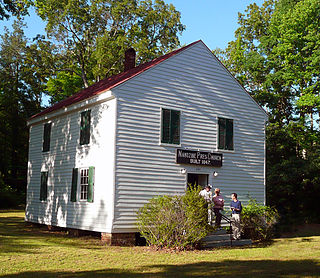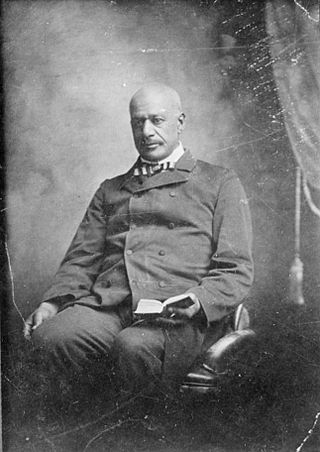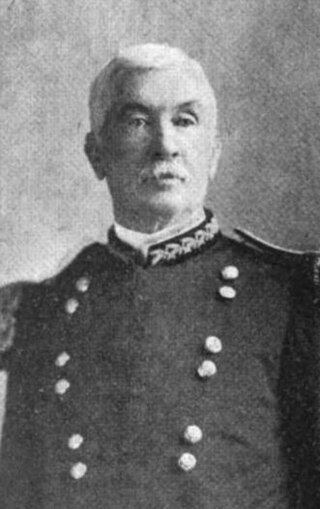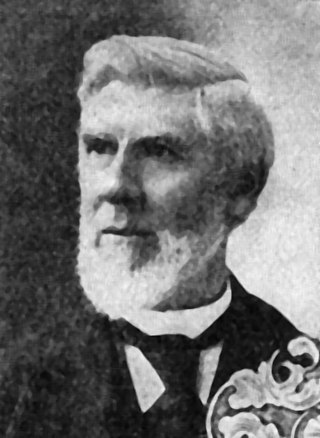William H. Woodall | |
|---|---|
| Born | Lynchburg, Virginia |
| Allegiance | United States |
| Service | United States Army (civilian employee) |
| Rank | Chief Civilian Scout |
| Unit | Jessie Scouts |
| Battles / wars | American Civil War |
| Awards | Medal of Honor |
William H. Woodall was a civilian employee of the Union Army during the American Civil War and a recipient of the U.S. military's highest decoration, the Medal of Honor, for his actions at the Battle of Namozine Church. He is one of only a handful of civilians to have received the medal.
Born in Lynchburg, Virginia, Woodall was living in Winchester, Virginia, when he was hired by the U.S. Army. He served as the Chief Civilian Scout for Major General Philip Sheridan's Cavalry Corps and rode with the Jessie Scouts, an irregular group of spies which infiltrated Southern territory by dressing in Confederate uniforms. During the Battle of Namozine Church, Virginia, on April 3, 1865, he was among a group of Jessie Scouts that captured Confederate Brigadier General Rufus Barringer. Woodall himself seized the general's headquarters flag, for which he was formally presented with the Medal of Honor a month later, on May 3, 1865, in Washington, D.C. [1] [2] [3]
Woodall's official Medal of Honor citation reads:
Captured flag of Brigadier General Rufus Barringer's headquarters brigade. [2]
A 1916 review of all Medals of Honor awarded by the Army resulted in the revocation of 900 medals, including Woodall's. He and four other civilian scouts had their awards rescinded due to their civilian status. In June 1989, the U.S. Army Board of Correction of Records restored the medal to all five of these men. [1] [2]
The flag which Woodall captured is now held by the North Carolina Museum of History. [3]

Thomas Ward Custer was a United States Army officer and two-time recipient of the Medal of Honor for bravery during the American Civil War. A younger brother of George Armstrong Custer, he served as his aide at the Battle of Little Bighorn against the Lakota and Cheyenne in the Montana Territory. The two of them, along with their younger brother, Boston Custer, were killed in the overwhelming defeat of United States forces.

The Battle of Sailor's Creek was fought on April 6, 1865, near Farmville, Virginia, as part of the Appomattox Campaign, near the end of the American Civil War. It was the last major engagement between the Confederate Army of Northern Virginia, commanded by General Robert E. Lee, and the Army of the Potomac, under the overall direction of Union General-in-Chief Lieutenant General Ulysses S. Grant.

The Appomattox campaign was a series of American Civil War battles fought March 29 – April 9, 1865, in Virginia that concluded with the surrender of Confederate General Robert E. Lee's Army of Northern Virginia to forces of the Union Army under the overall command of Lieutenant General Ulysses S. Grant, marking the effective end of the war.

The Battle of Namozine Church was an engagement in Amelia County, Virginia, between Union Army and Confederate States Army forces that occurred on April 3, 1865, during the Appomattox Campaign of the American Civil War. The battle was the first engagement between units of General Robert E. Lee's Confederate Army of Northern Virginia after that army's evacuation of Petersburg and Richmond, Virginia, on April 2, 1865, and units of the Union Army under the immediate command of Maj. Gen. Philip Sheridan, who was still acting independently as commander of the Army of the Shenandoah, and under the overall direction of Union General-in-Chief Lt. Gen. Ulysses S. Grant. The forces immediately engaged in the battle were brigades of the cavalry division of Union Brig. Gen. and Brevet Maj. Gen. George Armstrong Custer, especially the brigade of Colonel and Brevet Brig. Gen. William Wells, and the Confederate rear guard cavalry brigades of Brig. Gen. William P. Roberts and Brig. Gen. Rufus Barringer and later in the engagement, Confederate infantry from the division of Maj. Gen. Bushrod Johnson.

Rufus Clay Barringer was a North Carolina lawyer, politician, and Confederate brigadier general during the American Civil War.

Rufus Saxton was a Union Army brigadier general during the American Civil War who received America's highest military decoration, the Medal of Honor, for his actions defending Harpers Ferry during Confederate General Jackson's Valley Campaign. After the war he served as the Freedmen's Bureau's first assistant commissioner.

The 1st West Virginia Cavalry Regiment served in the Union Army during the American Civil War. Although it started slowly, it became one of the most active and effective of the West Virginia Civil War regiments—and had 14 Medal of Honor recipients, the most for any West Virginia regiment during the war. It was originally called the 1st Virginia Cavalry, not to be confused with the Confederate 1st Virginia Cavalry. Some reports added "Union," "Loyal" or "West" when identifying this regiment. After the Unionist state of West Virginia was officially admitted to the Union in 1863, the regiment became the 1st West Virginia Cavalry Regiment. The National Park Service identifies it as the 1st Regiment, West Virginia Cavalry.

James Daniel Gardner, also spelled as Gardiner, was an African American Union Army soldier during the American Civil War and a recipient of the United States military's highest decoration, the Medal of Honor, for his actions at the Battle of Chaffin's Farm.
Hartwell Thomas Benton Compson was an American military officer who received the Medal of Honor for heroism in the American Civil War.
Smith Larimer was a corporal in the 2nd Ohio Cavalry, Union Army and a Medal of Honor recipient for his actions at the Battle of Sayler's Creek in the American Civil War.

John Lilley was a United States soldier who was recognized with his nation's highest award for valor, the U.S. Medal of Honor, for his gallantry during the American Civil War. While fighting with Company F of the 205th Pennsylvania Infantry as part of the Union Army engaged in the Third Battle of Petersburg, Virginia on April 2, 1865, he captured the flag of the Confederate States Army by single-handedly rushing, and forcing the surrender of, that army's color-bearer, along with several additional CSA soldiers.
Hispanics in the American Civil War fought on both the Union and Confederate sides of the conflict. Not all the Hispanics who fought in the American Civil War were "Hispanic Americans" — in other words citizens of the United States. Many of them were Spanish subjects or nationals from countries in the Caribbean, Central and South America. Some were born in what later became a U.S. territory and therefore did not have the right to U.S. citizenship. It is estimated that approximately 3,500 Hispanics, mostly Mexican-Americans, Puerto Ricans and Cubans living in the United States joined the war: 2,500 for the Confederacy and 1,000 for the Union. This number increased to 10,000 by the end of the war.

John Francis Weston was a Union Army officer in the American Civil War and a recipient of the United States military's highest decoration, the Medal of Honor, for his actions during a raid on Confederate shipping. He was a brigadier general of United States Volunteers in the Spanish–American War. Weston retired from the U.S. regular army in 1909 as a major general. Having been assistant commissary general of subsistence and commissary general of subsistence from 1897 to 1905, including commissary general for the American forces in Cuba during the Spanish–American War, Weston finished his career as the highest ranking U.S. Army officer in the Philippines and, in the last year of his service, as commander of the Department of California.

Charles H. Marsh was a Union Army soldier in the American Civil War and a recipient of the United States military's highest decoration, the Medal of Honor, for his actions during a skirmish in the Valley Campaigns of 1864.

Eri Davidson Woodbury was a Union Army officer during the American Civil War. He received the Medal of Honor for gallantry during the Battle of Cedar Creek fought near Middletown, Virginia on October 19, 1864. The battle was the decisive engagement of Major General Philip Sheridan’s Valley Campaigns of 1864 and was the largest battle fought in the Shenandoah Valley.

The Battle of Fairfax Court House was the first land engagement of the American Civil War with fatal casualties. On June 1, 1861, a Union scouting party clashed with the local militia in Fairfax, Virginia, resulting in the war's first deaths in action, and the first wounding of a field-grade officer.

Christopher C. Bruton (1841–1867) was a Union Army officer during the American Civil War. He received the Medal of Honor for gallantry during the Battle of Waynesboro, Virginia fought on March 2, 1865. It was the final battle for Confederate Lt. Gen. Jubal Early, whose force was destroyed.
Thomas A. Anderson was a United States soldier and native of Pennsylvania who fought with the Union Army as a corporal in Company I of the 1st West Virginia Cavalry during the American Civil War. He was awarded his nation's highest award for valor, the U.S. Medal of Honor, for capturing the flag of a Confederate regiment during the Battle of Appomattox Station on April 8, 1865. The award was conferred on May 3 of that same year.

Thomas R. Kerr was a soldier in the Union Army in the American Civil War. Kerr received his country's highest award for bravery during combat, the Medal of Honor. Kerr's medal was won for his capturing the flag of the Confederate 8th Virginia Cavalry Regiment at Moorefield in West Virginia on August 7, 1864. He was honored with the award on June 13, 1894.